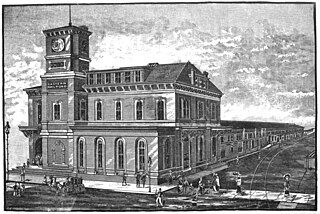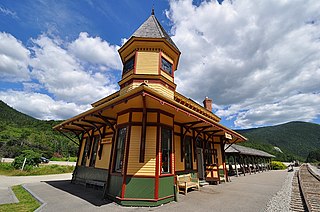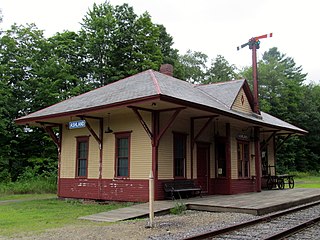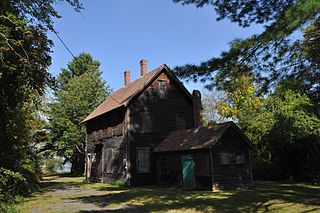
Epping is a town in Rockingham County, New Hampshire, United States. The population was 7,125 at the 2020 census, up from 6,411 at the 2010 census.

Raymond is a town in Rockingham County, New Hampshire, United States. The population was 10,684 at the 2020 census. Part of Pawtuckaway State Park is in the north.
The Lexington and West Cambridge Railroad was a railroad company chartered in 1845 and opened in 1846 that operated in eastern Massachusetts. It and its successors provided passenger service until 1977 and freight service until 1980 or early 1981.

Bellows Falls station is an Amtrak intercity rail station located in the Bellows Falls village of Rockingham, Vermont, United States. The station is served by the single daily round trip of the Washington, D.C.–St. Albans Vermonter. It has a single side platform adjacent to the single track of the New England Central Railroad mainline.

The Eastern Railroad was a railroad connecting Boston, Massachusetts to Portland, Maine. Throughout its history, it competed with the Boston and Maine Railroad for service between the two cities, until the Boston & Maine put an end to the competition by leasing the Eastern in December 1884. Much of the railroad's main line in Massachusetts is used by the MBTA's Newburyport/Rockport commuter rail line, and some unused parts of its right-of-way have been converted to rail trails.

West Concord station is an MBTA Commuter Rail station located in West Concord, Massachusetts. It is served by the Fitchburg Line. The station has two side platforms serving the line's two tracks, with mini-high platforms for accessibility. The adjacent station building, now a restaurant, is not used for railroad purposes.

North Conway station is a railway station located in North Conway, New Hampshire. Built in 1874, the depot was designed by Nathaniel J. Bradlee in an eclectic Russian Victorian style. The station is also the terminus for the Conway Scenic Railroad. Northwest of the station stands a roundhouse, which now houses the Scenic Railroad's rolling stock; it was built around the same time as the station. The yard and depot were added to the National Register of Historic Places in 1979 as North Conway Depot and Railroad Yard.

Crawford Depot, also known as Maine Central Passenger Railway Station, is a historic passenger railroad station at the top of Crawford Notch in the Bretton Woods area of the town of Carroll, New Hampshire. Built in 1891, it is a surviving emblem of the importance of the railroad in the area's history as a tourist destination, and is one of the finest examples of Queen Anne railroad architecture in northern New England. Now home to a visitors center operated by the Appalachian Mountain Club, it was listed on the National Register of Historic Places in 1982. It is also the northern terminus of most trains on the "Notch Train" service of the Conway Scenic Railroad.

White River Junction Historic District is a historic district in the unincorporated village of White River Junction, within the town of Hartford, Vermont. It was first listed on the National Register of Historic Places in 1980, and its boundaries were increased in 2002 and 2019. It originally encompassed the central portion of the village's business district, and was then expanded to include a broader array of resources.

The Potter Place Railroad Station is a historic railroad station on Depot Street in Andover, New Hampshire. Built in 1874, it is one of the best-preserved surviving 19th-century railroad stations in Merrimack County. It now houses the museum of the Andover Historical Society. It was listed on the National Register of Historic Places in 1989.

The Laconia Passenger Station is a historic railroad station at 9-23 Veterans Square in downtown Laconia, New Hampshire. It was built in 1892 for the Boston and Maine (B&M) Railroad and is a prominent regional example of Richardsonian Romanesque style architecture. It was added to the National Register of Historic Places in 1982. The building now houses a variety of commercial businesses.

The Contoocook Railroad Bridge is a covered bridge on the former Contoocook Valley Railroad line spanning the Contoocook River in the center of the village of Contoocook, New Hampshire, United States. It is referred to in the National Register of Historic Places as the Hopkinton Railroad Covered Bridge, for the town of Hopkinton, New Hampshire, in which the village of Contoocook is located.

The Chicago and Northwestern Railroad Depot is a railroad station located between Suffolk and Lowell Streets in Ironwood, Michigan. It was listed on the National Register of Historic Places in 1985.

The Contoocook Railroad Depot is located in Hopkinton, New Hampshire, United States, in the village of Contoocook. The depot was completed in 1849 as one of the first substantial railroad passenger stations west of Concord on the Concord and Claremont Railroad. The building is one of the best preserved of a small number of gable-roofed railroad stations surviving from the first decade of rail development in New Hampshire. The station exemplifies the pioneering period of rail development in the state.

The Ashland Railroad Station is a historic train station at 39 Depot Street in Ashland, New Hampshire. Built in 1869 and remodeled in 1891, it is a well-preserved example of a rural 19th-century railroad station. It is now a museum operated by the Ashland Historical Society. The station was listed on the National Register of Historic Places in 1982.

The Newington Railroad Depot is a historic railroad station on Bloody Point Road in Newington, New Hampshire. Built in 1873, it is an unusual railroad-related structure, serving as a passenger and freight depot, and as the residence of the stationmaster, who also performed the role of toll collector for the nearby bridge. It is the only surviving 19th-century railroad-related structure in Newington. Now vacant and owned by the state, the building was listed on the National Register of Historic Places in 2010.

The Sandown Depot is a former railroad station of the Boston and Maine Railroad in Sandown, New Hampshire. Built in 1873–74, it is the best-preserved of stations built by the Nashua and Rochester Railroad to survive, remaining relatively unaltered since its construction, and still at its original location. It is now a local history museum, and was listed on the National Register of Historic Places in 1986, and the New Hampshire State Register of Historic Places in 2011.
The Former Maine Central Railroad Depot is a historic railroad station on Maine State Route 7 in Brooks, Maine. Built in 1892, it is an extremely well-preserved and little-altered example of a Queen Anne railroad depot. It served as a passenger depot until 1960 and as a freight depot thereafter. It is owned by the Brooks Historical Society. It was listed on the National Register of Historic Places in 2009.

North Bennington station is a historic railroad station at Depot Street and Buckley Road in North Bennington, Vermont. Built in 1880 as a passenger station, this Second Empire brick building is a surviving reminder of North Bennington's former importance as a major railroad hub in southwestern Vermont. It was listed on the National Register of Historic Places in 1973 as North Bennington Depot.
The Morrisville Depot located at 10 Depot Street in Morrisville, Vermont, is a decommissioned historic train station. Built in 1872 to serve the Portland and Ogdensburg Railway, the depot was known as the most important train station for the Vermont lumber industry, for its decorative architectural ornament, and for housing the headquarters of the St. Johnsbury and Lamoille County Railroad from 1959 to the early 1970s. It was subsequently converted into a restaurant. The Morrisville Depot was added to the National Register of Historic Places in 1982 as building #15 in the Morrisville Historic District.




















